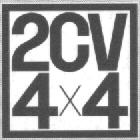 CitroŽn 2 CV 4x4 alpin
CitroŽn 2 CV 4x4 alpin 
CitroŽn 2 CV - based vehicles are not so rare:
Turboís historical tractor at the Ebensee-meeting or HeinzĎ lawn-traktor at teh 2001 - Worldmeeting are well known.
Last summer i learnt about such a construction in my home county, in Osttirol.
We had a beautiful autumn sunshiny day. So we mounted the car and got on the way to check that rumor
Before that, a quick call to the owner of the vehicle.
In Virgen, a small village, we meet the owner's wife, who took us to the "WetterkreuzhŁtte" 2160 m above sea level in a CitroŽn Jumper 4x4 via a narrow pathway. On the way up
we learnt a lot about the device, so that we were keen on seeing it. When we arrived, the lady said, the vehicle is "up there in the meadow"
After an approximately 10 min walk we are "up there in the meadow"
A doublebox made of steel, based on 4 wheels, enclosed with a barbed wire for their own protection or the protection of others, who knows? This vehicle is used by the Tschoner family in Virgen in order to bring food, beverages and equipment from the "Wetterkreuz"-lodge up to the Zuppalseehuette, 2350 m high via a narrow alpine pathway. After a bad accident which Mr. Tschoner suffered with a vehicle he could sit on, getting heavy injuries causing a several weeks hospital stay , he wanted a construction, from which he could escape easily in case of a rollover. The brothers Moser from Virgen (they even supported the engine from an old 2 CV) and Mr. Tschoner built this alpine cat.
The heart is a 602 cm≥ 2 CV engine, which is mounted in front of the steering-wheel in the rear section. At its flywheel a hydraulic oil compressor from German company Bosch is flanged to. This couple drives the rest of the "cat":
From the pump a hose leads to the oil pressure-engine/torque converter, having shafts to the respective axles, which results in an all wheel-drive. Both axles are provided with differentials from "normal" cars eg. OPEL (I don't know exactly), the track being 800 mm. The tires have the size 155 SR 15, the rim support plates are obviously welded directly to the axles. The engine and the compressor load the rear axle, the transducer and the payload rest on the front axle
Steering is done by a steering wheel, both sections being bent against each other, which requires a rather complicated drive shaft between the two sections.
The brakes are drive-shaft disk brakes, and work likewise hydraulically.
The device has been used for the last ten years, recently showing up leakages in the hydraulic system, but nevertheless transporting beer-barrels and other vital things on a way 1 m narrow, up to 2350 m above sea-level for the happyness of the visitors of the splendid high alpine area there.
Click on the small picture and get to the larger one
 the device |
 the device |
 the device |
 that's the way |
 The 2 CV-Motor |
 Steering and coil |
 The brake |
 The bend-steering |
 back |